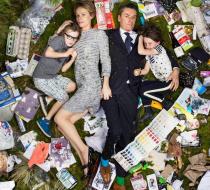7 Days of Garbage Favorite
Gregg Segal -- a California-based artist who is known for using the medium of photography to explore culture with the "sensibility of a sociologist" -- asked family, friends, neighbors and other acquaintances to save their trash and recyclables for a week and then lie down and be photographed in it:
“I created the settings for the pictures in my yard in Altadena, CA: water, forest, beach and snow. Garbage is pervasive; no environment is untouched ... I shot from above to make it very clinical and clean and graphic. It’s kind of a nest, a bed we’re lying in with all this stuff, forcing us to reconcile what we’re producing, which hopefully causes some people to think a little bit more about what they’re consuming.”
Gregg Segal also included a shot with his own family, including his wife and eight-year-old son:
"I didn’t want to act like I’m separate. I wasn’t crazy about the picture, but I do think it’s important to show people. It’s not like I’m pointing the finger at them. I’m pointing it at all of us.”
By personalizing the problem of waste, Gregg Segal encouraged both the participants photographed and the audience to consider the garbage they produced in a blunt and unusual way. Those who were photographed were asked to confront their garbage extremely literally:
"They thought it was kind of gross. I think there’s something mildly humiliating about it, but in a constructive way,” Segal said. “It’s kind of a once in a lifetime experience for people to be photographed with all their stuff. I think it’s seen as a kind of novelty for some people and the question of grossness was mitigated by the novelty factor.”








